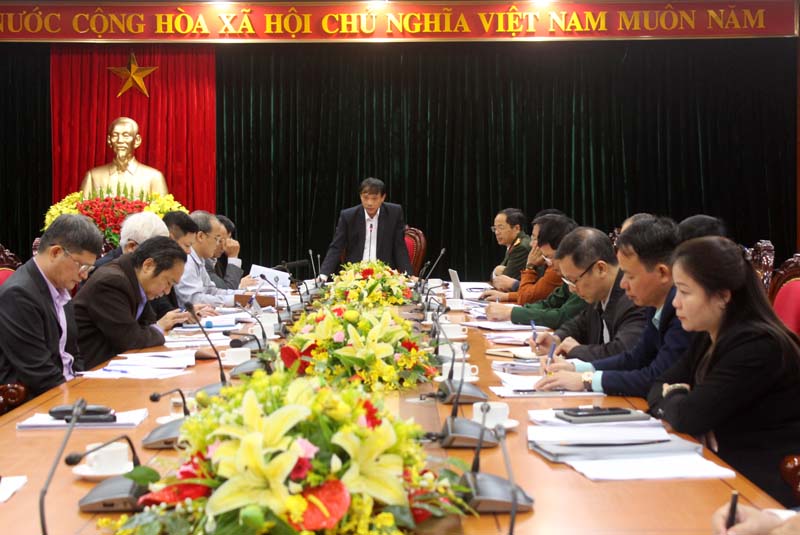
(HBO) – The Hoa Binh People’s Committee has held a conference to review the five-year socio-economic situation in 2016-2020 and define a five-year socio-economic development plan for 2021-2025.
Between
2016 and 2020, the average annual gross regional domestic product (GRDP) of the
province has reached 9.15 percent. By 2020, agriculture, forestry and fishery sector
is expected to account for 19 percent of the GRDP, industry-construction 47
percent, services 29.2 percent, and product taxes 4.8 percent.
Meanwhile, the per capita GRDP is expected to
reach 64 million VND, State budget collection to come to 5 trillion VND, and
the number of effectively operating businesses and cooperatives to amount to 2,470
businesses, doubling that of 2015.
The
total export turnover will exceed 1.9 billion USD, 3.5 times over the figure in
2015. The rate of urbanisation will reach 25 percent, and 45 percent of
communes along with three districts will be recognised as new rural areas.
Participants agreed on the overall targets for the
2021-2025 period, with the province to mobilise all resources to promote rapid
and sustainable economic growth, with industry being the driving force, tourism
as the spearhead and agriculture moving towards commercial scale production.
The material and spiritual life of people will be improved remarkably, and ethnic
cultural identities preserved and developed.
The province will also enhance the management
capacity and efficiency of authorities at all levels and proactively cope with
climate change, make reasonable use of natural resources, well control
environmental pollution, and ensure defence-security.
Hoa Binh will strive to become a middle-range province
by 2025 with all economic indications and most social indices ranked in the
middle-range group among all localities in the country.
Some
specific targets for 2021-2025 are: average economic growth of 9.5-10 percent,
per capita GRDP of about 100 million VND, and annual State budget collection
increase of 17 percent. The total import-export turnover in 2025 is expected to
rise by 3.5 times compared to 2020. The rate of urbanisation will surpass 35
percent./.
Hoa Binh province is undergoing a dynamic transformation amid Vietnam’s national digital transition. Building on Poliburo’s Resolution No. 57-NQ/TW on breakthroughs in science, technology, innovation, and national digital transformation, the province has rolled out a wide range of practical action plans. A standout initiative is the "Digital Literacy for All” movement, an effort to ensure that no one is left behind in the digital era.
Hoa Binh province is undergoing a dynamic transformation in the wake of the national digital transformation movement. Building on Resolution No. 57-NQ/TW of the Politburo on breakthroughs in science, technology, innovation, and national digital transformation, the province has implemented a wide range of practical action plans. A standout initiative is the "Digital Literacy for All” movement ambitious effort to ensure that no one is left behind in the digital age.
With a spirit of unity and proactive problem-solving, the Party Committee, the government and the people of Dong Lai Commune (Tan Lac District) have made great strides in implementing the resolutions of the 24th Party Congress of the commune for the 2020 - 2025 term. Focusing on leadership and practical actions, the commune has brought the Party’s resolutions into daily life, creating strong impacts and pushing the local development forward.
Amid the nationwide push for digital transformation, young people in Hoa Binh Province are stepping up as dynamic pioneers, applying technology to enhance Youth Union operations and expand the reach of youth-led initiatives. Through creativity and adaptability, Youth Union organizations at all levels have introduced a series of practical solutions, contributing to modern governance and community development.
In recent years, An Nghia commune, located in Lac Son district, has stepped up administrative reform, focusing on improving the quality and efficiency of its single-window service unit for receiving and processing administrative procedures. These improvements have helped create favourable conditions for local residents and organisations to handle administrative procedures, contributing to the commune’s broader socio-economic development.
The Prime Minister-approved master plan to develop the multi-use value of forests ecosystems through 2030, with a vision to 2050, aims to improve the management and sustainable use of forest resources, create jobs, increase incomes, and improve the living standards of ethnic minorities, people in mountainous and remote areas, forest workers and those living near forests.



